5 Reasons to Visit the Cairngorms in Spring
Spring in the Cairngorms brings longer days, milder temperatures, and a renewed sense of life across the landscape. As the snow melts and the valleys turn green, this is one of the best times of year to experience the natural beauty of Scotland’s largest national park. Whether you’re a keen walker, wildlife enthusiast, or simply looking for a peaceful escape, here are five great reasons to visit the Cairngorms in spring.
As winter retreats, the Cairngorms become a haven for wildlife. Red squirrels, pine martens, and roe deer become more visible, while ospreys return to their nests after wintering in Africa. The hills echo with the calls of black grouse and capercaillie, making spring an exciting time for birdwatchers.
Red squirrels and mountain hare are also becoming more active. We also have beavers and wildcat which you might be able to spot if you’re lucky.
Scot Mountain Holidays offers guided trips that provide the best chances to spot these elusive species in their natural habitat.
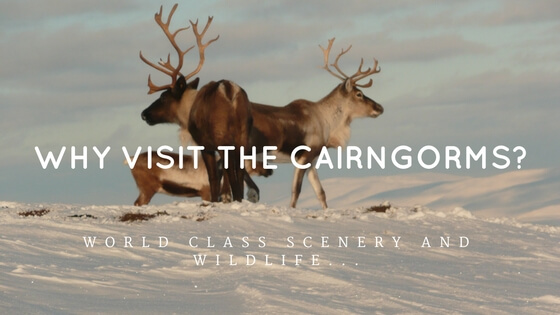
Unique wildlife and scenery plus so much more
Spring offers some of the best conditions for exploring the mountains and glens, with crisp mornings, comfortable daytime temperatures, and trails that are much quieter than in summer. Whether you prefer a gentle riverside stroll or a challenging hill walk, the Cairngorms cater to all abilities. For cycling enthusiasts, the drier trails and improved weather make it a fantastic time for both road biking and mountain biking.
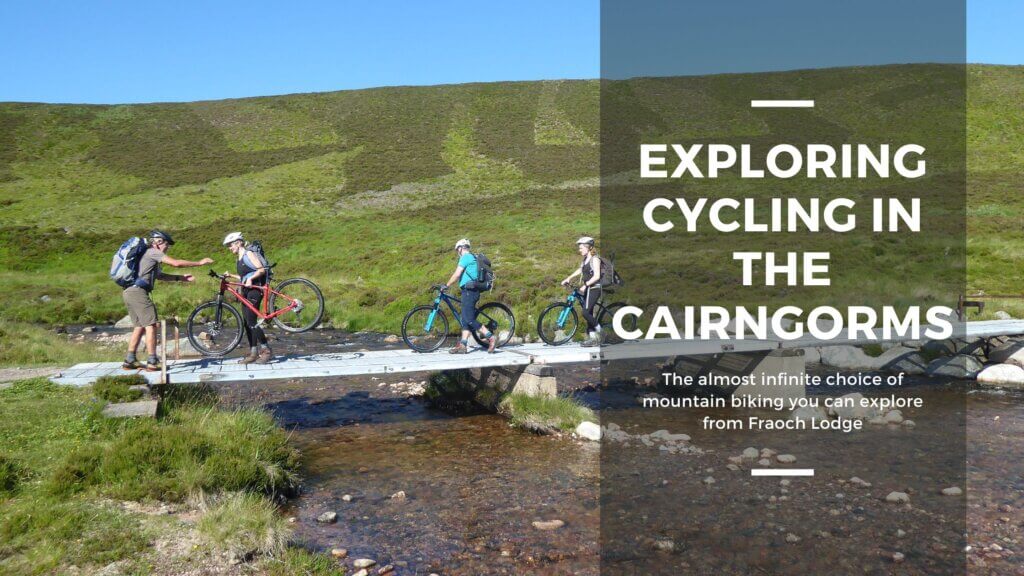
The transformation of the Cairngorms in spring is truly stunning. Heather moorlands, ancient forests, and meadows come alive with wildflowers, and fresh green leaves begin to cover the trees. It’s also one of the best times to visit the ancient Caledonian pine forests, where new life is emerging and the scent of pine fills the air.
Spring is a fantastic time to experience the Cairngorms without the summer crowds. Many of the most popular trails and viewpoints remain quiet, allowing for a more peaceful connection with nature. If you’re looking for a true escape, staying at Fraoch Lodge offers a comfortable and welcoming base to explore the area without the rush of peak season tourism.
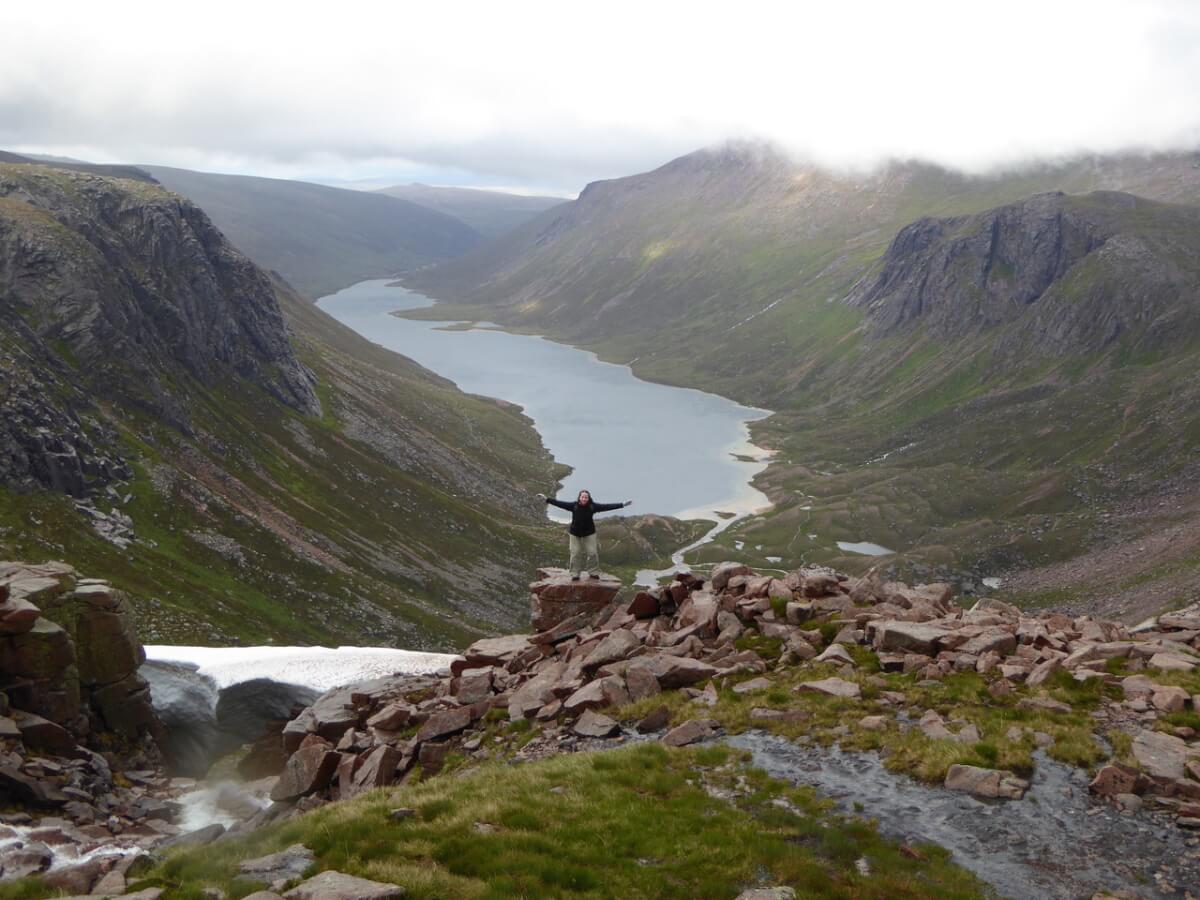
Posing amid the grandeur of the Cairngorms scenery
Spring brings a variety of events to the Cairngorms, from walking festivals to family-friendly activities. The Ballater Walking Festival in May is a great way to explore the area with expert guidance, while events like the Highland Games taster sessions provide an insight into local traditions. There are also several cycling and trail running events for those looking for a challenge in a spectacular setting.
The Cairngorms in spring offer a unique mix of adventure, wildlife, and relaxation. Whether you want to enjoy the landscape in full bloom, take part in outdoor activities, or simply soak up the tranquillity of the Highlands, Scot Mountain Holidays and Fraoch Lodge provide the perfect base for your visit. With expert local knowledge and a warm welcome, you’ll be well-placed to make the most of this special season.

Enjoy top class family friendly and freshly prepared food.
Have you had any Easter holiday ideas yet? Thinking about the Easter holidays this year, it’s a wee bit of an awkward time – so early in the Spring season. It’s still an opportunity for some winter sports, but spring is on its way. If you’re travelling up to the Cairngorms National Park for this Easter holiday here are some ideas you might want to consider:
Experience the ultimate wild camping adventure with our exclusive hot tent camping setup, supported by Highland ponies. Hike through ancient pine forests, past serene lochs, and into breathtaking mountain landscapes. By night, enjoy the warmth of our cozy, heated tents and the luxury of hot showers—even in the heart of the wilderness! This UK-first experience is an unforgettable Easter holiday idea for families and adventure seekers alike.
👉 Book now and make Easter 2025 truly special!
Ever wondered what it’s like to sleep in a snowhole? This Easter, you can experience the thrill of a night in the Cairngorms, safely guided by Andy, Scotland’s most experienced snowhole expert. He’s built over 100 snow shelters in the past 20 years—so you’re in safe hands!
👉 Contact Andy for a private guided expedition.
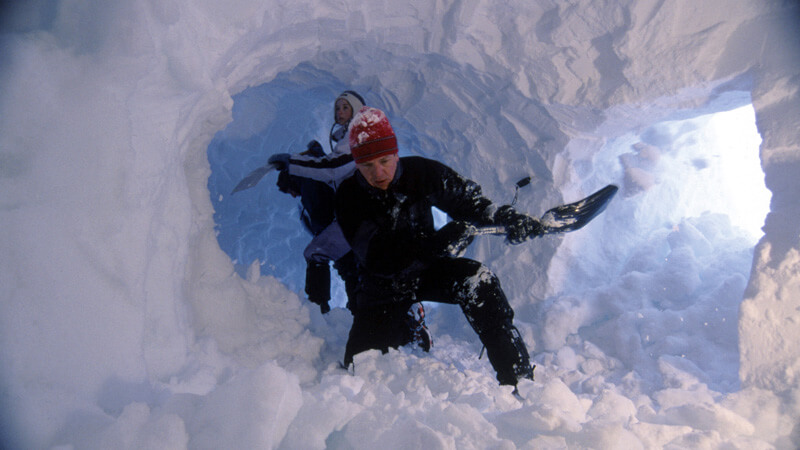
Digging in for a night out on the mountain.
Join us for a guided summit hike and discover the awe-inspiring landscapes of the Cairngorms. Whether you’re an experienced hillwalker or just looking for a safe and enjoyable mountain experience, our expert guides will tailor a walk to your level.
👉 Enquire now about guided hikes.

Posing amid the grandeur of the Cairngorms scenery
From Highland Cows and red deer to reindeer and pine martens, the Cairngorms are teeming with wildlife. For young explorers, we can organize a range of exciting experiences, including:
👉 Contact us for a tailored wildlife itinerary.
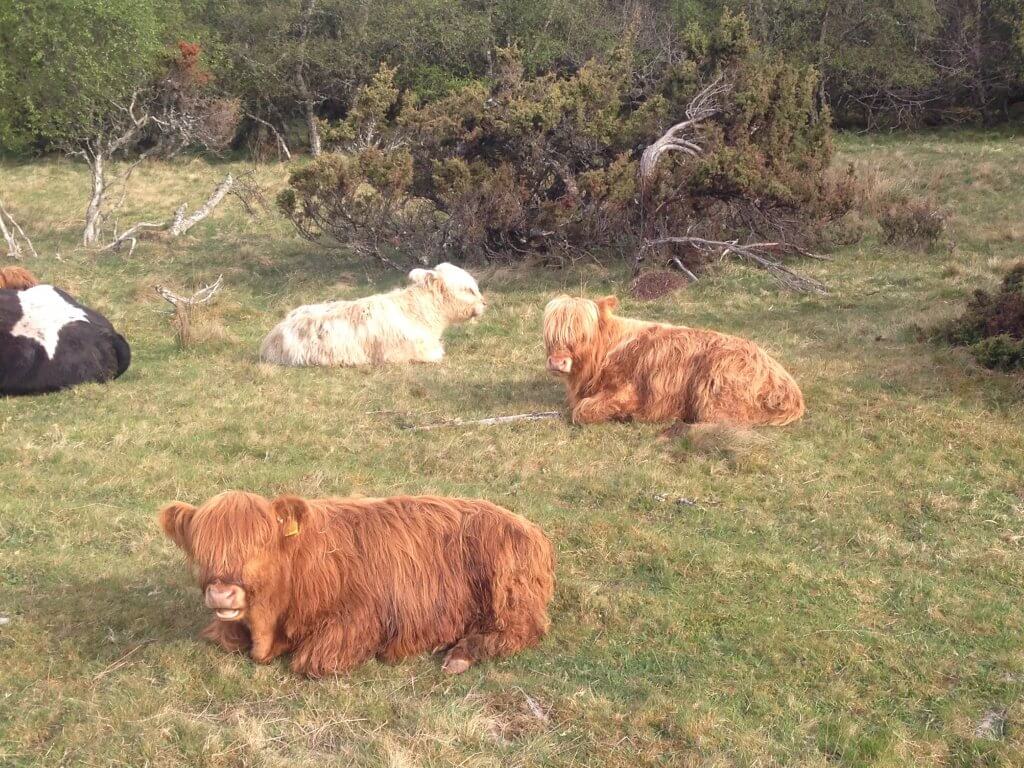
If you’re lucky you’ll pass the wee herd of Heelan Coo next to the road for a photo shoot.
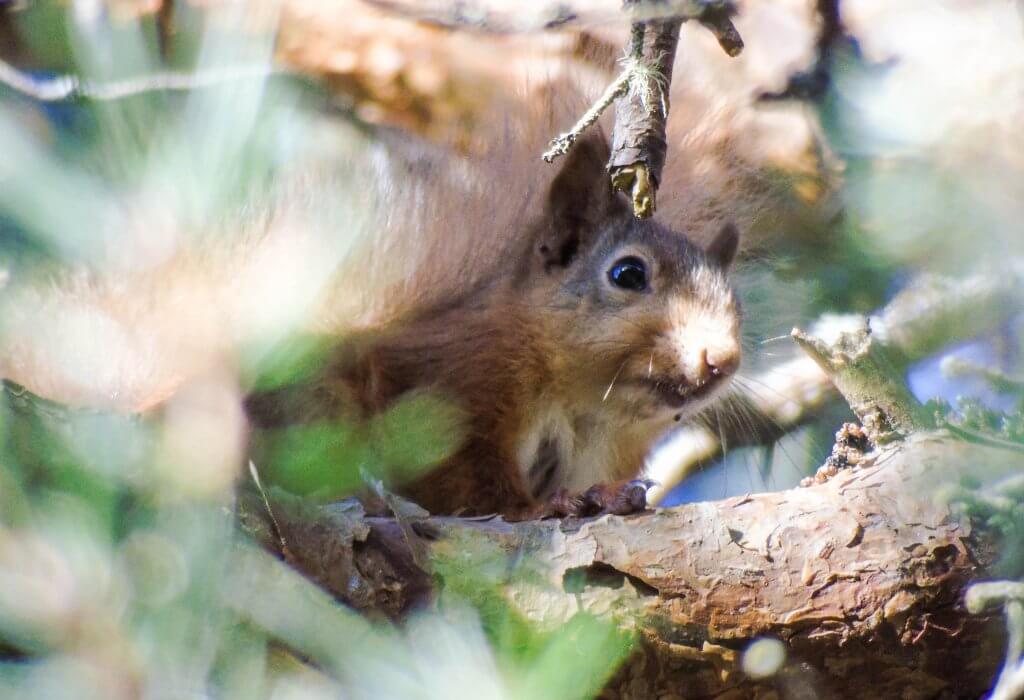
The Scottish red squirrel, photographed in the Boat of Garten woods.
No trip to Scotland is complete without sampling some of its finest whiskies! Visit the Speyside Cooperage to see the craftsmanship behind whisky casks, then explore a nearby distillery of your choice. If you’re an early riser, you might even catch a tour at Dalwhinnie Distillery! Glenfarclas Distillery or Tomintoul Distillery! Watch out for road closures around Tomintoul though in April and early May 2025.
👉 We also offer Mountains & Malts tours—ask us for details!
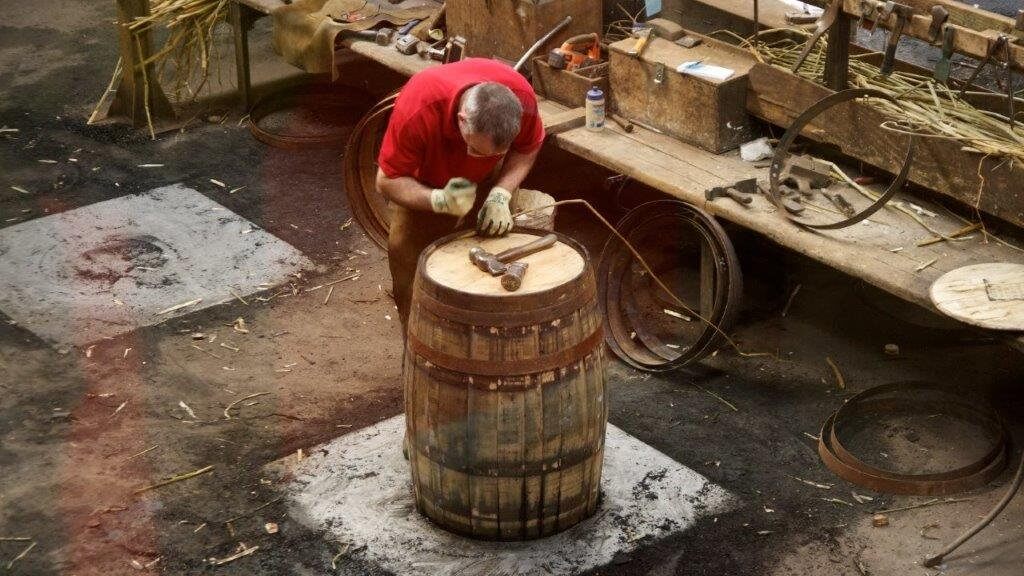
A cooper hard at work repairing casks at the Speyside Cooperage
There are a huge number of Munros accessible from Fraoch Lodge. There are Munros to climb almost from the doorstep in the Cairngorms National Park. You can also use Fraoch Lodge as your base and venture further afield. However, with Ben Macdui (2nd highest in Scotland) and Braeriach (3rd highest in Scotland), you shouldn’t need to travel far for a good workout. Do make sure you put your safety first though. This year (2018) with Easter being so early and a good covering of snow remaining, it would be a good idea to either take a local guide or make sure you have refreshed your snow skills before you venture into the hills. Contact us for a private guiding or instruction booking.
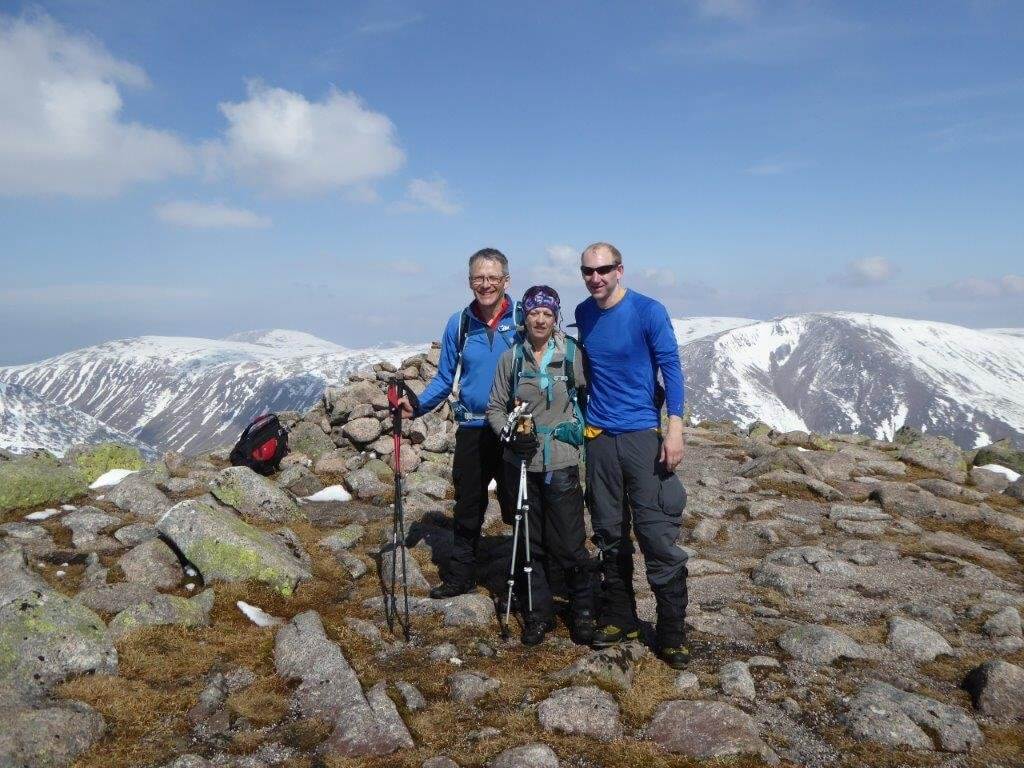
The hikers in the sunshine deep in the heart of the Cairngorms National Park (more snow than most of January). Taken April/May 2017.
Turn Easter into an adventure with geocaching or set up your own treasure hunt around the stunning Cairngorms landscape! And for a special Easter treat, our very own Rebecca is training in gourmet chocolate-making—so you could enjoy homemade chocolates straight from Fraoch Lodge!
👉 Stay with us for a delicious Easter experience!
FREE ACTIVITY
Spring may still bring chilly waters, but for the brave-hearted, Loch Morlich and Loch Insh offer fantastic opportunities for wild swimming, canoeing, and kayaking. If you’re new to wild swimming, pick up a guidebook or ask us for the best local spots!
Yes, you can still ski at Easter (some years)! The Cairngorm Mountain ski area often holds snow well into April, offering great conditions for skiing, snowboarding, and sledging. Equipment hire and lessons are available locally. Check how much skiing is available before you book. The funicular is running again but currently (04.03.25) there is extremely limited skiing on Cairngorm, no firm base and warm weather.
Get your heart racing with an exhilarating ride on the G2 Outdoor Zip Line, just outside Aviemore. Soar over the forest canopy for an unforgettable thrill—perfect for families and adventure lovers.
Make the most of Easter 2025 with a stay at Fraoch Lodge, your home away from home in the Cairngorms. Whether you want an action-packed adventure or a relaxing retreat, we’ll help you create the perfect itinerary.
📍 Book your accommodation at Fraoch Lodge now! 📩 Contact us for custom holiday packages and guided adventures.
In no particular order we’ve listed 10 of our favourite family walks in the Cairngorms. We’ve concentrated on the area we know best around the northern side of the park, but we do also know of some excellent walks on the south side of the park which we’ll mention in passing with reference to more detailed information at the end of the blog.
We’ve concentrated on walks which you can do with younger children as once your kids reach a certain age, they’re capable of achieving just as much on a day hike as any other adult.

Ascending Meall a’Bhucaille with 2 x 7 year olds and 1 x 4 year old.
Of the family walks available in the Cairngorms, this is one of the most popular, also frequented by some of the minibus tour companies like Rabbies.
The walk takes about 2 hours or 4.5 miles
It is a lovely walk to do. You don’t have to do the whole walk but the path is suitable for push chairs, particularly those with 3 wheels or larger wheel sizes.
The ruined castle on the island in the loch lends the situation a romantic aura. The area has featured in Outlander and the new Netflix extravaganza about King Arthur.
The optional extension around the neighbouring loch, is almost deserted. The path is wide and mostly through lovely open Caledonian pines. Even on a wet day, it is picturesque.
In summer, you can snack your way round on the wild bilberries which line the path in places.
Map of the route, courtesy of Walk Highlands.
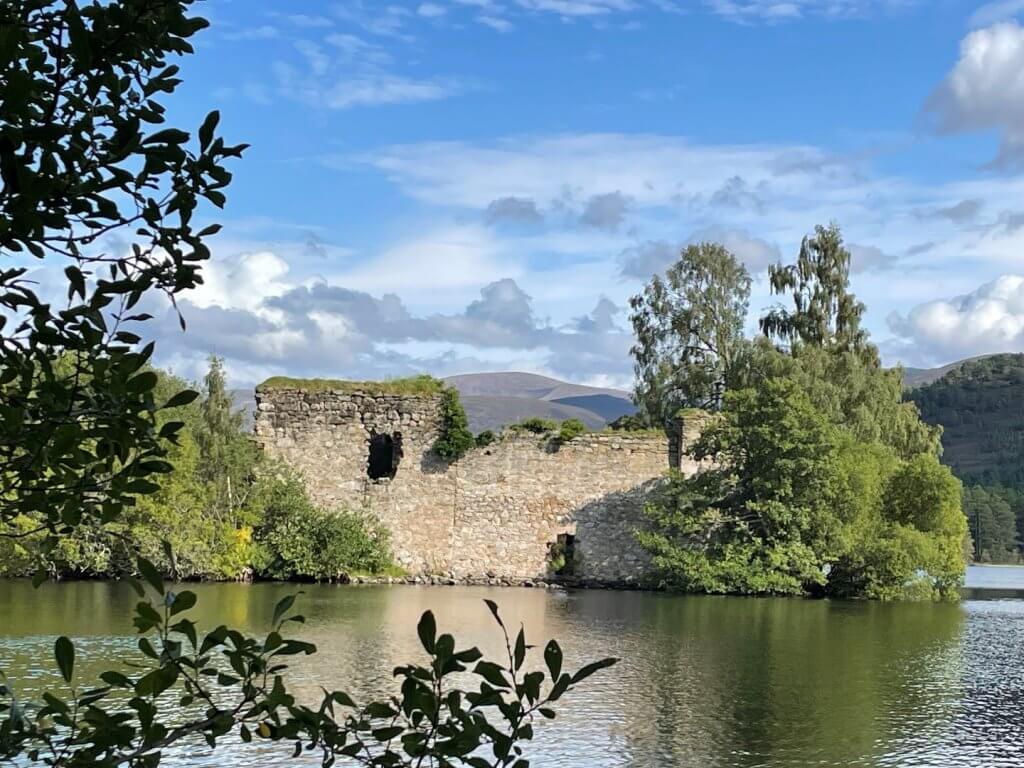
The famous castle on Loch an Eilean, Glens, Forests and Lochs
An easy walk to fit into a bigger day of activities. Going up to the Green Lochan and back to your car will only take about 1 hour.
1.2 miles: 26 mins (one way)
Start at Glenmore Lodge or the Forestry Commission Visitor Information Centre in Glenmore. Parking at the end of the road by Glenmore Lodge is limited and on a fine day you may find that there is no space there. If you are parked at the end of the road, near the visitor information centre, you will end the walk at the Cobbs cafe. A cake break here makes a fine reward at the end of the day.
The path is wide and easy to find up to the Green Lochan. It starts from the road end and continues straight up to the Green Lochan. Allow time to stop at the lochan take in the views and maybe even dabble your toes in the water. There’s a great spot for photos too.
If this is not enough of a walk for you and your family the route continues on to Ryvoan Bothy. The Bothy is a basic shelter, like a refuge. It is free to use and does not have a warden. The main thing to remember is that you should not leave anything at the bothy which wasn’t there when you arrived. You can spend the night at Ryvoan Bothy, but be prepared for some competition for the “bed” space. There is a small stove in the bothy, so providing you have fuel, you should be warm enough.
Here’s a link to the map of Walk Highland’s version of this walk which can also be done as a there and back route from your car parked outside Glenmore Lodge for a shorter route.
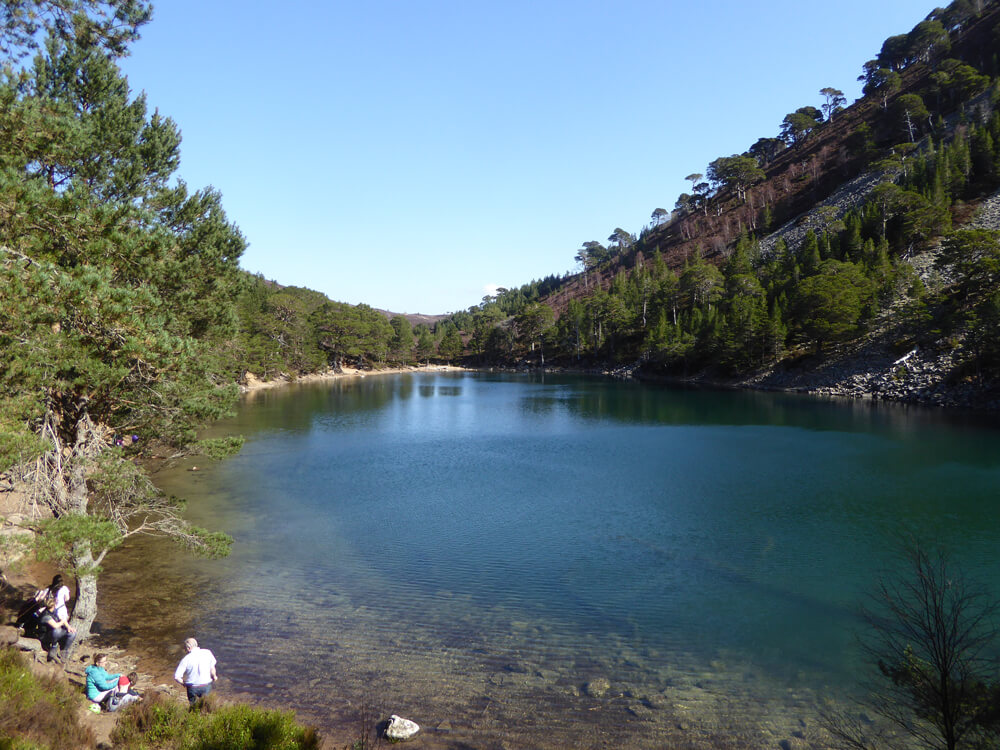
Perfect spot to rest up after a wee walk. Popular in the middle of the day.
This is a lovely walk at any time of year in almost any weather conditions. The majority of the walk is through mature Caledonian pine forest which bears no resemblance whatsoever to commercial forestry. The trees are not all straight nor are they planted in rows. The undergrowth is lush and often filled with treasures like wild blueberries, cowberries or mushrooms. You could see a red squirrel, roe deer, crested tits, ospreys etc
At Loch Garten you have the option of visiting the Osprey Hide and hearing the ongoing saga of the Osprey centre (April to August only).
Including Loch Mallachie on your circuit is a must. It is a beautiful spot and really quite peaceful. Sunrise is glorious here if you’re an early riser.
2 – 3 hours: 9km, plus walk through Boat of Garten to the car park if you are starting from Fraoch Lodge
Map courtesy of Walk Highlands
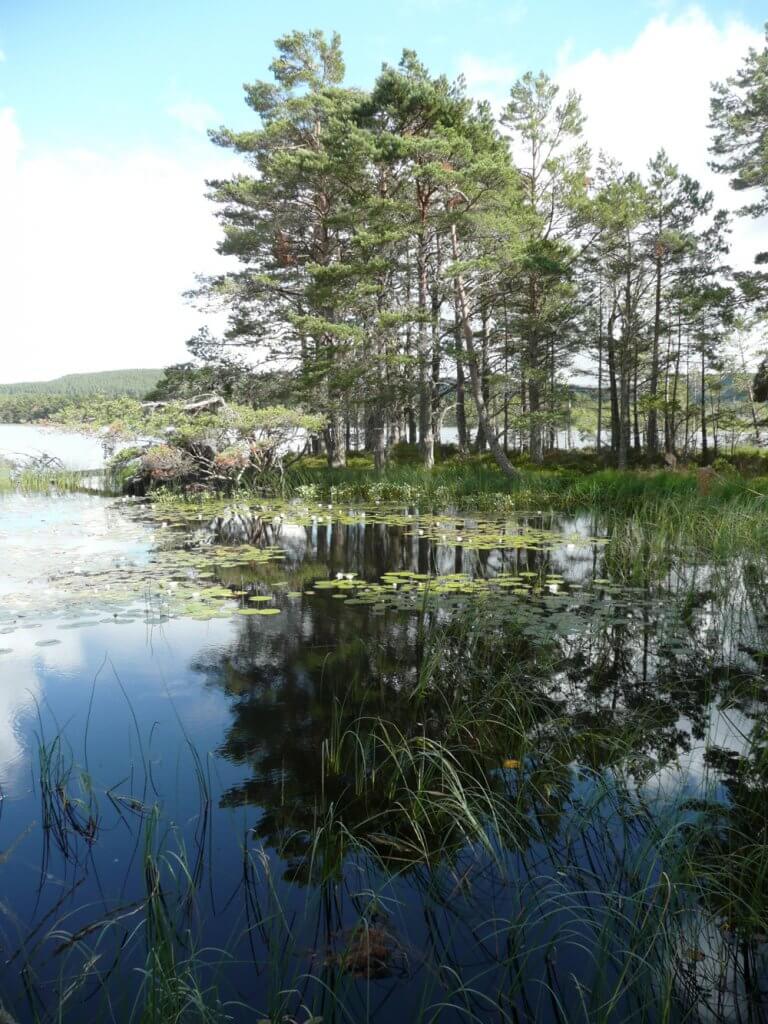
The peaceful scenery of Loch Mallachie, near Boat of Garten
This is a short way-marked circular route of 5km.
You’ll start either from the centre of Grantown, or from the caravan park (though parking is limited here). The route starts on a tarmaced track leading off left past the caravan park. You’ll then pick up signs for the Dava Way and the viewpoint walk to the right. Follow the track up the hill along the side of the stream. You’ll pass a couple of points where you can admire the view over Grantown to the Cromdale hills before reaching the ultimate viewpoint marker, atop a small rocky outcrop. Here you’ll find a viewpoint marker indicating all the mountains etc you can see.
Continue on from the viewpoint to make the walk a circular route, finishing up along the old railway track which is now part of the Dava Way.
There are opportunities to Geocache along the way if you feel the need to add a bit of interest to the walk.
For a full route description try Walk Highlands
This is a really short walk suitable for even the youngest members of the family. It follows the river Nethy from the bridge in the centre of Nethybridge up towards the Dell of Abernethy. There are also plenty of opportunities to extend the walk along the local network of paths, the majority of which are waymarked.
You can also pick up a map at the information centre in the village hall right at the start of your walk.
There are alternative routes out to Broomhill station and Castle Roy on the other side of Nethybridge.
Take the steam train from Boat of Garten to Broomhill. Follow the walking route into Nethybridge and either pick you way to the river where there is a wee beach where you can relax. You can paddle in the shallows too. But watch out, because there are deeper patches in the middle of the river. Don’t try to wade out to the other side.
From here you could also pick up the Speyside way and walk all the way back to Boat of Garten which is no more than 5 miles and probably less. It’s a great walk with plenty of opportunities in the summer to stop and snack on bilberries (wild blueberries).
There are plenty of Geocache possibilities in Nethybridge too to keep the kids focused.
Ellan Woods are again filled with Geocache boxes. Even if you don’t travel that far, the kids will have a great time trying to retrieve as many prizes as they can.
Parts of the off-road route 7 cycle path also pass through Carrbridge.
If you’re looking for a longer alternative, we do include a Carrbridge circuit in our self-guided Cairngorm itinerary. You could also take a look at the week long itinerary of self-guided walks: we could adapt this trip for your group.
Sluggan bridge as a walk on it’s own is suitable for almost anyone to do. It is just a quick stretch of the legs, but can easily be extended and is such as lovely spot that you can easily spend an afternoon there with the kids. Dabble in the water and have a picnic.
This is a wee favourite of ours. A little jaunt up to a viewpoint above Aviemore, or if you have really wee ones just go to the wee lochans. You’d hardly know you’re right next to the A9.
The walk is about 5km so probably not one for really young ones. Parts of it were a wee bit icy when we did it (admittedly that was March and really only to be expected). Lovely walk which breaks out of the birch forest to provide spectacular views as below. Some steep sections but easily managed by anyone of moderate fitness. Walking poles advised if you are not used to hill walking.
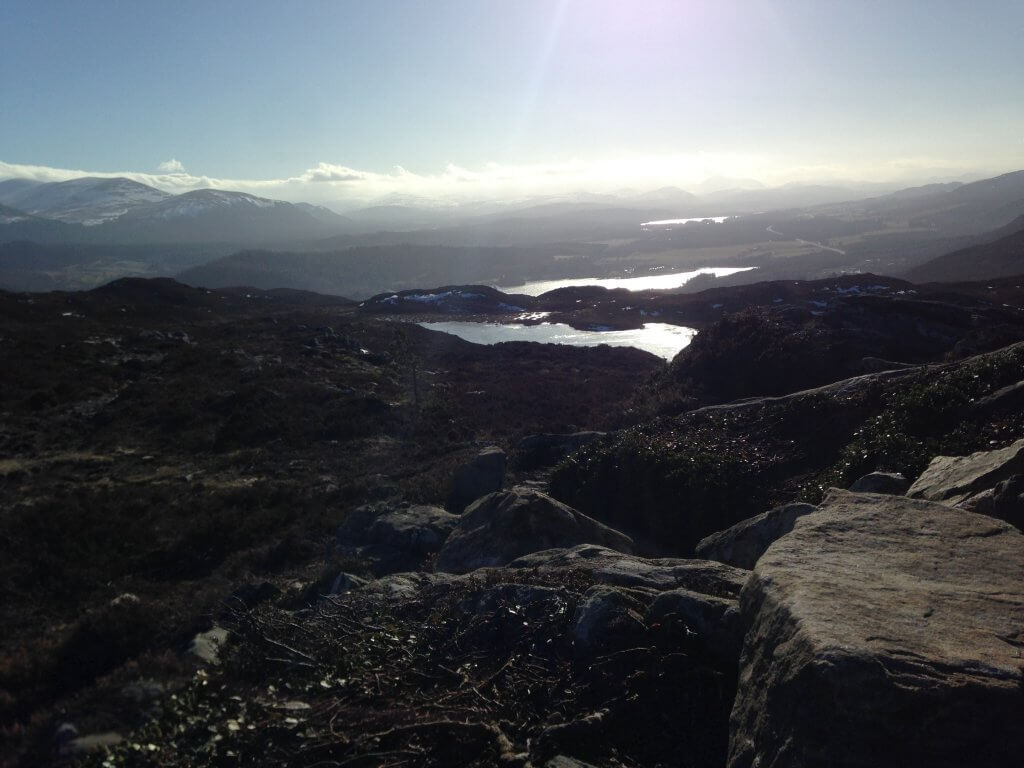
Spectacular and unusual views from the viewpoint above Craigellachie Nature Reserve
Well worth a wee gander across the moor to Aviemore. You follow the route of the Strathspey Railway most of the way to Aviemore as well as the course of the river Spey. This is part of the Speyside Way. It is a well maintained wide path. You’ll be heading towards the Cairngorms so spectacular views of the mountains. The only downside is that there is very little shelter for the majority of the route though the beginning and the end are protected by trees.
Points of interest:
You can come out into Aviemore on the Dalfaber estate, right next to Cairngorm Brewery. Worth a stop? They do brewery tours! Also near here: Kilted Fudge (for the kids to pick up a treat) and Route 7 Cafe.
You can return by steam train to Boat of Garten if you time it right, or alternatively take the public bus service (no. 34) back to the village.
5 to 6 miles, depending on how far into Aviemore you go.
We’ve already covered this option in some detail in a previous blog. Do click on the link for full details. This is a very popular family walk. Plenty of treats for the younger kids to encourage them to the top.
This is quite a walk for wee kids, but don’t forget if it’s your first attempt and the kids get tired, you usually have the option of taking the funicular train back down (providing you remember your wallet).
Again it is easy to extend this walk if you want or keep it short and just pop in at the Ptarmigan restaurant at the top for snacks and refreshments.
Do not attempt this walk with young kids in the winter months.
From the ski car park to the summit is: just over 4km, 2 – 2.5 hr walking
Remember: there is no shelter or shade on this walk. Cairngorm is sub-arctic tundra. Most of the vegetation is less than knee high. There are trees but they are of the dwarf variety and don’t even reach you knees. You’d have to know what you’re looking at to identify them as trees!
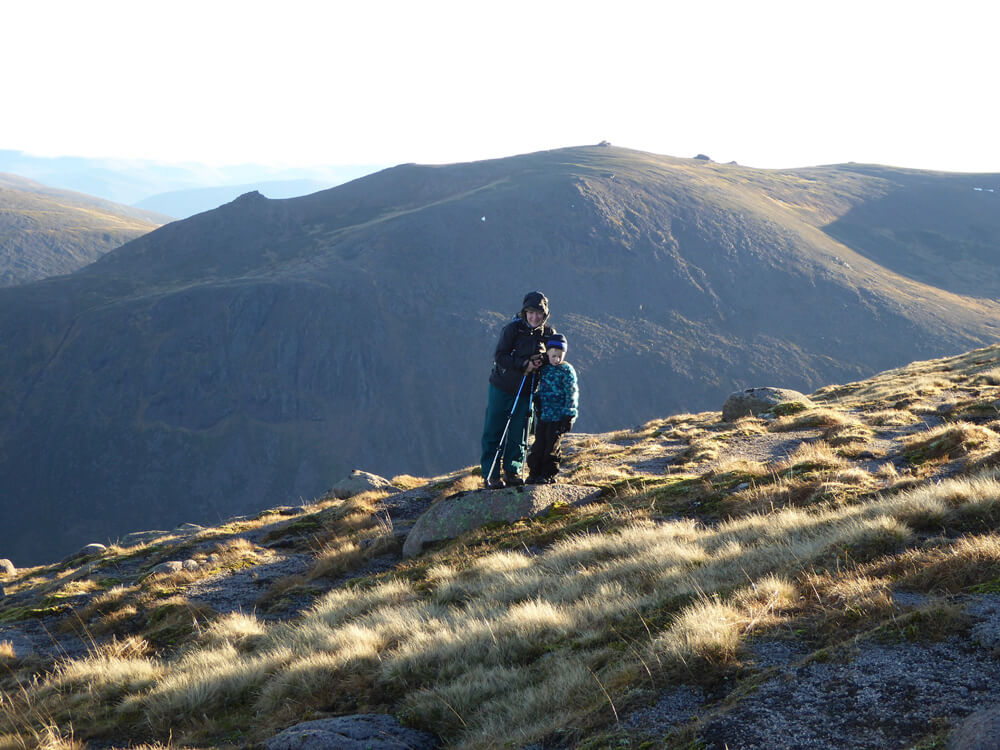
A family day out on the summit of Cairngorm (with diversions to hunt for snow)
For maps and full route descriptions try WalkHighlands
For leaflets on the community trails around many of the villages in the Cairngorms click here
Visit Scotland’s suggestions for scenic family walks
Best hikes in the Cairngorms from the Guardian.
https://blog.visitcairngorms.com/six-great-walks-beginners-families/
How to Stay Safe in the Scottish Winter Mountains: Essential Tips for Hiking and Climbing
Scotland’s winter hills offer unparalleled beauty and adventure, but venturing into this environment requires preparation and caution. The #ThinkWINTER campaign by the Mountaineering Council of Scotland aims to raise awareness about safety in winter conditions, offering practical advice to keep adventurers safe. With over 1,000 mountain rescues occurring annually across the UK, preparedness is crucial. Here’s how to ensure your trip is both enjoyable and safe.
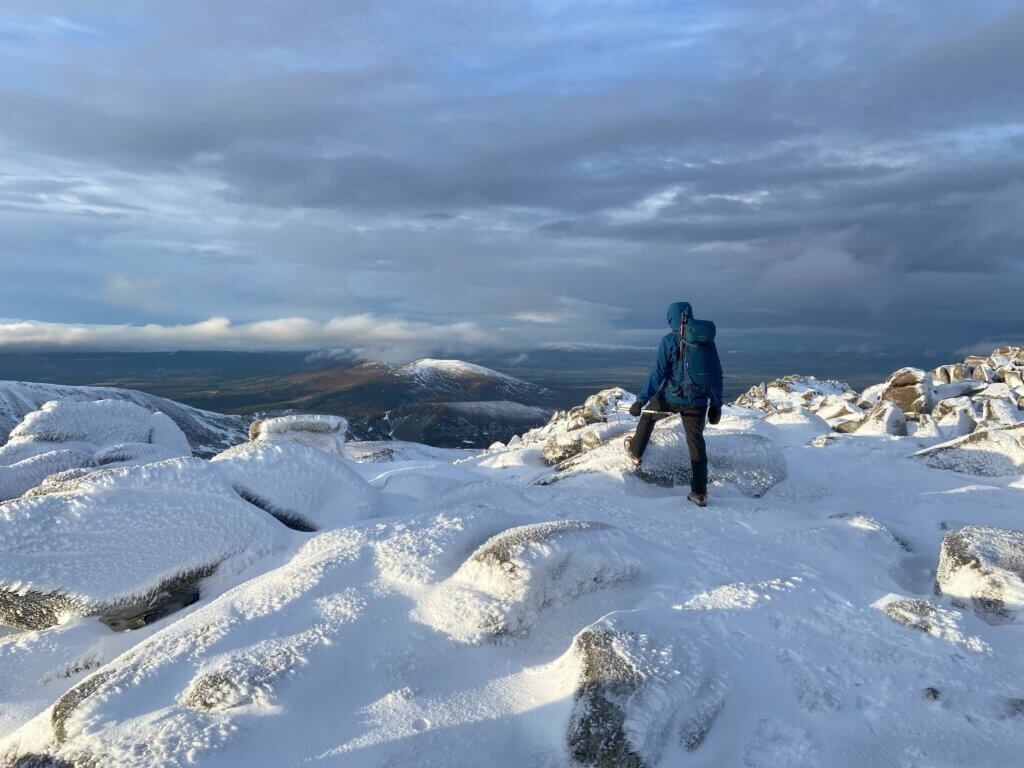
1. Comprehensive Planning
2. Weather and Avalanche Awareness
3. Clothing and Equipment
4. Skill Development

Test your limits, within your means
For those uncertain about navigating Scotland’s winter hills, guided trips provide a safe alternative. Scot Mountain Holidays offers guided hiking and climbing adventures, alongside accommodation, transport, and full catering. With their expert knowledge, you’ll experience the beauty of the Scottish Highlands safely and comfortably.
The #ThinkWINTER campaign encourages hikers and climbers to:
By adopting these practices, you can reduce your risk and enjoy your adventure responsibly. Remember, mountain safety isn’t just about you—it ensures rescue teams, often volunteers, aren’t unnecessarily called into dangerous situations.
Prepare wisely, respect the mountains, and embrace Scotland’s winter magic with confidence!
5 Reasons to Visit the Cairngorms in Winter
The Cairngorms in winter offer a completely different experience from the rest of the UK. Snow-covered peaks, quiet trails, and crisp mountain air make it an ideal destination for those looking to explore Scotland’s wild landscapes in the colder months. Whether you’re keen on winter walking, improving your mountain skills, or simply enjoying the peace and beauty of the Highlands, the Cairngorms have plenty to offer. Here are five reasons to visit:
The Cairngorms contain Britain’s highest and most extensive mountain plateau, giving them some of the most reliable winter conditions in the UK. Snow lingers well into spring, creating an environment more akin to Scandinavia than anywhere else in Britain. With Scot Mountain Holidays, you can explore this unique winter landscape safely, whether on foot, or even cross-country skis.
The Cairngorms offer some of the best winter walking and mountaineering in the UK. Unlike other mountain ranges, their vast, high-altitude terrain provides a real winter experience, with deep snow and ice often lasting for months. Whether you’re looking for a straightforward hill walk or something more technical, Scot Mountain Holidays can guide you through the best routes while ensuring you stay safe and build confidence in winter conditions.
It can be dangerous to get out into the hills in winter so it is highly recommended to take advantage of the plethora of local guides. You don’t want to be the reason the mountain rescue team are called out.
The Cairngorms are the top destination in the UK for learning winter mountain skills. With consistently snowy conditions and a variety of terrain, it’s the perfect place to learn how to use an ice axe, crampons, and navigate safely in winter. At Fraoch Lodge, we run winter skills courses to help hillwalkers and climbers develop the knowledge and confidence they need to enjoy the mountains in all conditions.
Learning the technical skills for both safe movement in the winter hills and whiteout navigation will eventually allow you go be independent in winter.
Winter in the Cairngorms offers some of the best wildlife watching opportunities in the UK. With the snow-covered landscape acting as a blank canvas, it’s much easier to spot elusive species like mountain hares, ptarmigan, red deer, and even golden eagles. Unlike more accessible national parks, the Cairngorms provide a real sense of remoteness, making wildlife encounters all the more special.
We can arrange winter wildlife trips for you or you can stay at Fraoch Lodge and arrange your own guide. We recommend either Speyside Wildlife or Malcolm at Arc Guiding. Malcolm is also a ski and mountain bike guide.
After a day exploring the wintery landscapes, there’s nothing better than returning to a warm, welcoming retreat. The Cairngorms offer a range of cosy accommodation, from traditional lodges to charming B&Bs & hostels. At Fraoch Lodge, we provide hearty home-cooked meals, a roaring fire, and a friendly atmosphere—perfect for unwinding and sharing stories of the day’s adventures. We also have a purpose built drying room for all your outdoor gear, complete with bar heaters (for a gentle heat under your boots) and a dehumidifier (to get rid of all that excess moisture).
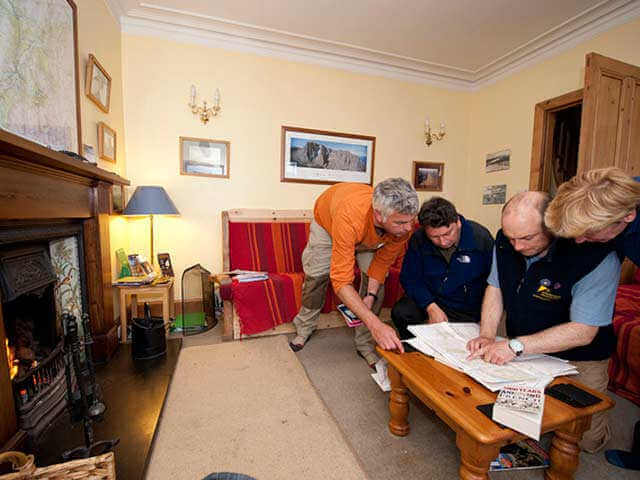
Enjoy the open fire and discussions in the lounge
Winter in the Cairngorms is a truly special experience, offering adventure, tranquillity, and the chance to connect with nature in its most magical season. Whether you’re keen to develop your skills, explore new landscapes, or simply soak up the beauty of Scotland in winter, there’s no better time to visit. If you’re looking for a guided experience or a welcoming base, Scot Mountain Holidays and Fraoch Lodge are here to help you make the most of your winter adventure.
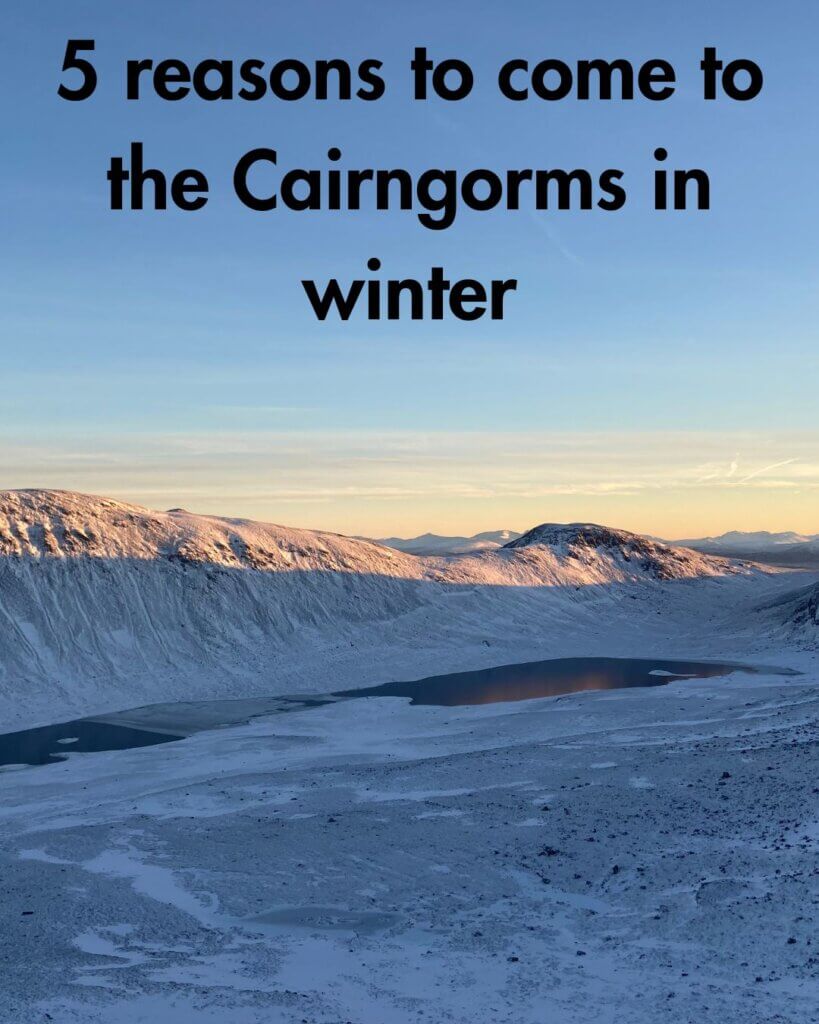
One of the most frequently asked questions from those joining our winter courses is: What if there is no snow? Although we can’t control the weather, we can almost guarantee there will be snow—especially on the high peaks during winter and early spring. However, for those still concerned, let us put your worries to rest.
The Cairngorms are home to Britain’s most permanent snow beds, some of which persist well into July or even early August. The high altitude and vast plateau of the Cairngorms make them a natural snow trap. Even in milder winters, the unique topography and wind patterns often ensure that snow is captured and retained in key areas. According to a study by the Royal Meteorological Society, the Cairngorm plateau experiences snow coverage for an average of 76 days per year, making it one of the most reliable locations for snow in the UK.
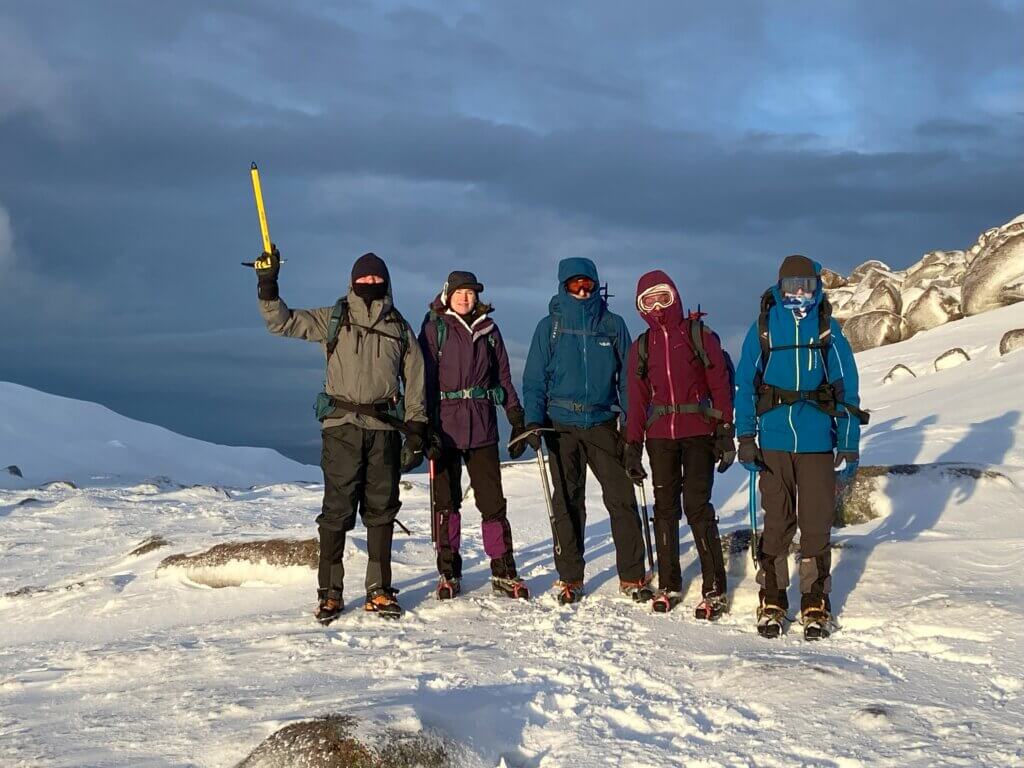
If, for some reason, the winter is unusually mild and snowfall is limited, it’s not the end of the world. Winter Skill courses with Scot Mountain Holidays are designed with flexibility in mind. Snow is just one of three critical factors that influence the course—the other two being wind (which facilitates snow drifting) and the expansive Cairngorm plateau (which helps to capture and hold snow).
Even if snow levels are lower, the skills taught during our courses remain relevant. In fact, hard, icy snow that forms after a thaw and subsequent freeze is often ideal for teaching crampon techniques. Fresh snow, while beautiful, doesn’t always add additional value to winter skills training.
In the 25 winter seasons that Scot Mountain Holidays has been running Winter Skills courses and hiking holidays, no course has ever been cancelled due to a lack of snow. This incredible track record highlights the reliability of the Cairngorms as a winter training destination.
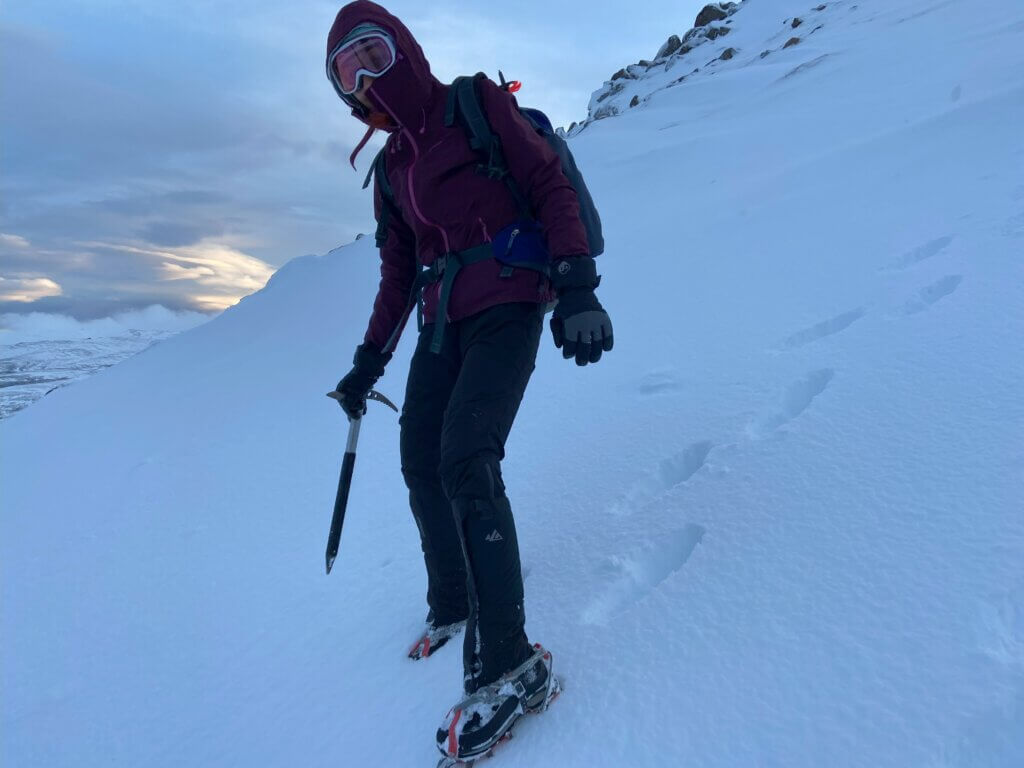
While snow is a strong likelihood on the peaks where our courses take place, there are many other elements that make your experience memorable. Thick, deep snow can sometimes make routes more strenuous. On the other hand, mixed conditions offer a chance to practice a wide variety of essential skills, including:
These skills are just as important, if not more so, than simply walking on deep snow.
Remember, winter skills are about preparing you for all types of conditions you might encounter in the mountains. Snow is a bonus, but not a requirement. The camaraderie, expert instruction, and opportunity to immerse yourself in Scotland’s stunning winter landscape are what truly make Scot Mountain Holidays’ courses unforgettable.
So, whether the snow is thick, patchy, or concentrated in specific areas, rest assured that your Winter Skills course will still be an incredible and valuable experience. The Cairngorms’ rugged beauty, combined with expert guidance, ensures your time with us is both safe and rewarding. As one participant noted, “The course was transformational—I learned so much, regardless of snow levels.”
Join us this winter to develop your confidence and skills in one of the UK’s most dramatic settings. With Scot Mountain Holidays, you’re in expert hands, and no matter the snow conditions, we’ll make sure your time in the Cairngorms is unforgettable.
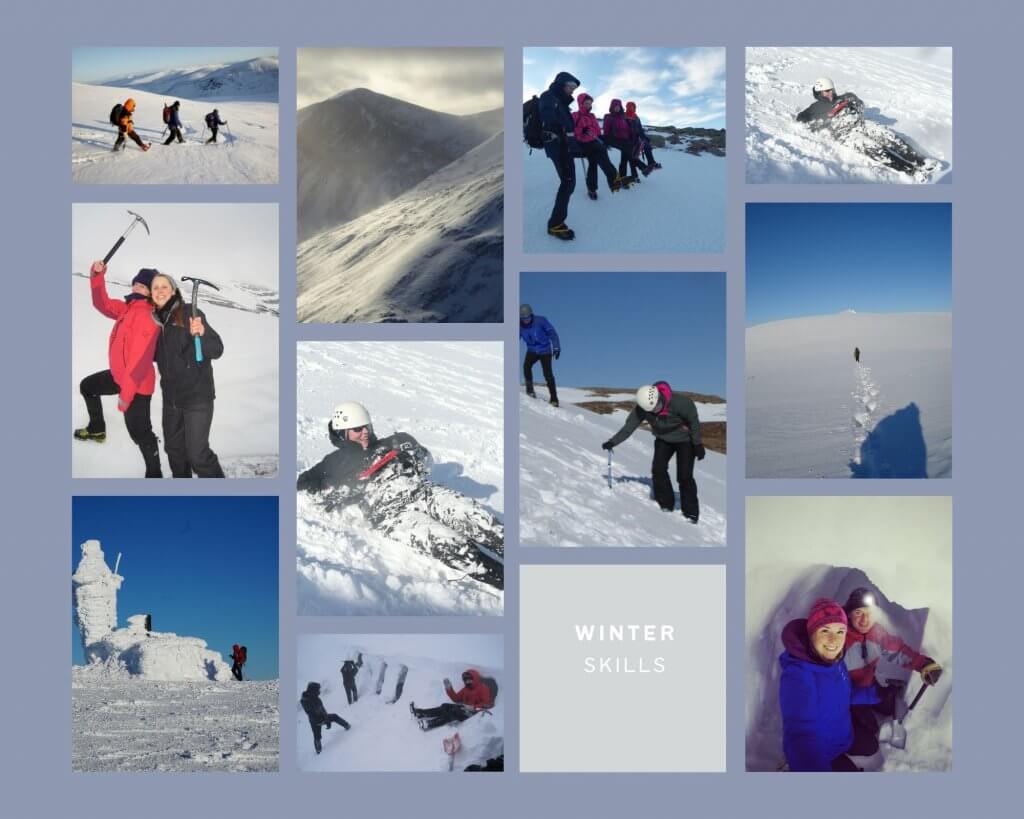
Scotland is a land of breathtaking beauty, with unique charms that shift with the seasons. While summer often steals the spotlight for visitors, winter remains a hidden gem offering raw beauty, crisp days, and unparalleled hiking experiences. If you’ve been hesitant to venture out during the colder months, let us convince you with five compelling reasons to go hiking in winter and join Scot Mountain Holidays for a trip you’ll never forget.
The peaks of Scotland are awe-inspiring at any time of year, but winter elevates their majesty to a whole new level. Snow-dusted summits, frost-kissed landscapes, and the clarity of winter skies combine to create an otherworldly spectacle. On clear days, the views are nothing short of magical, with the crisp air enhancing visibility and making every vista unforgettable. Scotland’s Cairngorms, for instance, often boast snow-covered peaks that rival the beauty of alpine ranges. Layer up, embrace the brisk wind, and let the beauty of hiking in winter reward your efforts.
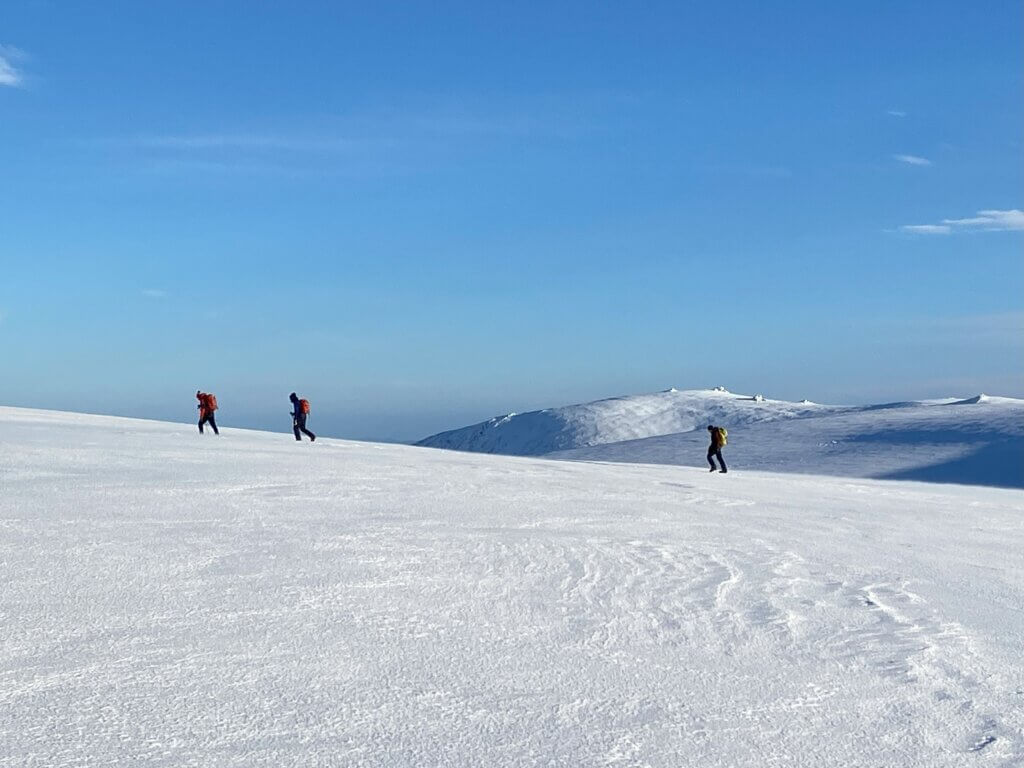
What a view! – New Year Winter Walking 2022 – 2023
The cold temperatures of winter naturally deter many would-be hikers, leaving the trails quieter and more serene. This means fewer crowds and more opportunities to immerse yourself in the solitude of Scotland’s wild spaces. With fewer distractions, you can fully connect with nature, reflect, and appreciate the tranquility of your surroundings. Imagine having iconic trails, like those in the Cairngorms or around Ben Nevis, almost entirely to yourself. It’s an unparalleled chance to experience Scotland’s rugged beauty in its purest form while hiking in winter.
Winter unveils a strikingly different perspective of Scotland’s landscapes. The absence of lush greenery exposes the raw, rugged beauty of the mountains—from dramatic rock formations to stark, snow-covered terrain. If you’re lucky enough to encounter fresh snowfall, the transformation is magical. The pristine white blanket enhances the contours and textures of the land, offering photographers and nature enthusiasts endless inspiration during their winter hikes. Plus, winter often brings incredible sunrises and sunsets that bathe the snow-dusted peaks in hues of gold and pink, perfect for unforgettable photos.
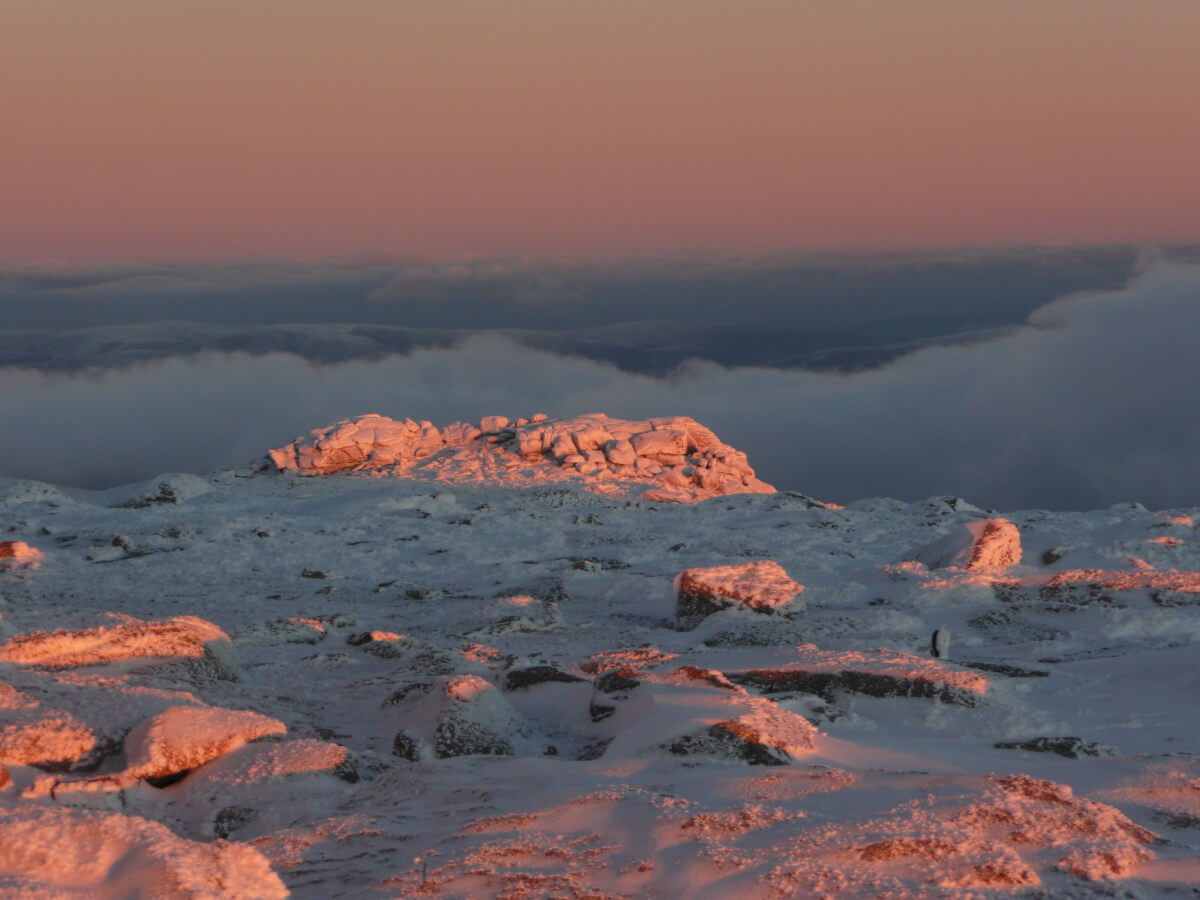
Winter sunset colours glowing on the snow covered Cairngorms
For the fitness-minded adventurer, hiking in winter provides an added bonus: increased calorie burn. The colder temperatures force your body to work harder to stay warm, meaning you’ll burn more calories compared to hiking in warmer weather. Add in the effort of navigating snow-covered paths, and your winter hike becomes an even more rewarding workout. Studies suggest that cold-weather exercise can burn up to 30% more calories, making winter hikes both invigorating and beneficial for your health.
Hiking in winter introduces unique challenges, from navigating icy trails to managing colder temperatures. These added elements demand a different level of preparation and skill, but they also offer an unparalleled sense of achievement. Conquering a winter hike builds confidence and leaves you with stories to share for years to come. Proper preparation—like wearing crampons and layering effectively—can transform these challenges into exciting opportunities to learn new skills. Plus, the sense of adventure and novelty makes every step more exciting.
If you’re ready to challenge yourself, embrace the season, and experience some of the most stunning terrain and views imaginable, hiking in winter in Scotland awaits. With the Cairngorms averaging over 100 days of snow cover per year, it’s one of the best places in the UK to experience a true winter wonderland. Join Scot Mountain Holidays for a guided adventure that will leave you with lasting memories and a newfound appreciation for this extraordinary season.
Setting off on expedition across the snowy Cairngorm plateau
New Scottish walking holidays for 2025: Discover More of Scotland’s Stunning Highlands
We’re excited to share our new Scottish walking holidays in 2025, designed to bring you closer to the landscapes and Munros you love. From the iconic heights of Ben Nevis to the serene charm of Arisaig, these trips offer a mix of challenge, beauty, and adventure for walkers who know and cherish Scotland’s Highlands.
Join us for an exhilarating short break to the remarkable Ben Alder, an untouched paradise nestled in the heart of Scotland’s Central Highlands. This challenging hiking experience offers breathtaking landscapes and a profound connection with nature.
📅 Dates: Arrive Tuesday January 21st
🥾 Difficulty: Challenging
🎒 Perfect For: Those looking for a winter walking break; a wilderness retreat
Familiar names, but always a fresh challenge. This trip takes in Ben Nevis, the UK’s highest peak, alongside the dramatic Munros of Glencoe. Expect classic Highland routes, rewarding ascents, and views that never fail to impress.
📅 Dates: Arrive Saturday 10thMay
🥾 Difficulty: Challenging
🎒 Perfect For: Those looking to revisit familiar heights or tick off iconic peaks
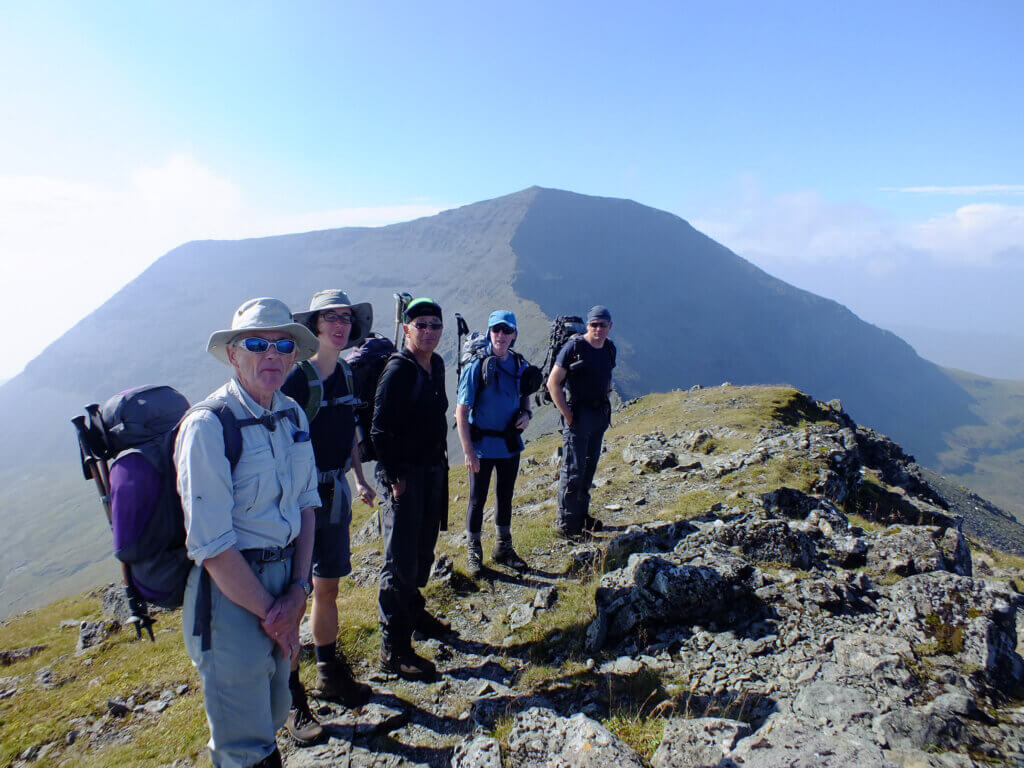
This summer trip focuses on the less-travelled Munros of Glen Garry, offering peaceful trails and stunning scenery. It’s a chance to explore quieter corners of the Highlands, with an emphasis on enjoying the journey as much as the summits.
📅 Dates: Sorry current dates are sold out. Please contact us to be put on the waiting list for next availability.
🥾 Difficulty: Challenging
🎒 Perfect For: Walkers seeking tranquility away from busier routes
Step away from the peaks and enjoy a coastal retreat with this relaxing trip. Arisaig’s mix of sandy beaches, rugged coastline, and gentle trails is perfect for unwinding while staying active. A slower-paced exploration with plenty of time to soak in the west coast’s natural beauty.
📅 Dates: Arrive Saturday 6th September
🥾 Difficulty: Moderate
🎒 Perfect For: Those looking for a change of pace and stunning coastal views
For seasoned walkers, the Kintail Munros offer a rugged and dramatic adventure. Famous for their ridges and panoramic views, this trip is a rewarding challenge in one of Scotland’s most striking regions.
📅 Dates: Arrive Saturday 13th September
🥾 Difficulty: Challenging
🎒 Perfect For: Experienced walkers ready for a physical and scenic challenge
Discover more about these trips and secure your place by booking here. Availability is limited, so don’t delay!
We can’t wait to welcome you back to the Highlands in 2025.
When you think of snow, it’s easy to picture adrenaline-filled days of skiing or snowboarding. But what if you’re not a fan of the slopes or simply want to try something different? Scotland offers a winter wonderland full of thrilling alternatives that let you embrace the snow in unique ways.
Here are Scot Mountain Holidays’ top four snowy adventures for non-skiers, perfect for creating magical winter memories.
Hiking isn’t just a summer activity—winter hiking offers a whole new level of magic. With snow-dusted trails and tranquil, crowd-free paths, it’s the perfect way to experience Scotland’s rugged beauty in its most serene form.
Yes, winter hiking comes with challenges, but the rewards are extraordinary. Picture yourself surrounded by glistening peaks, breathing in crisp mountain air, and savoring the quiet that only snow can bring. Just be sure to bundle up and prepare for the elements!
For those craving adventure with a side of learning, Scot Mountain Holidays offers snow skills courses that are as practical as they are exhilarating.
From mastering ice axes to building emergency snow shelters or navigating icy terrain, these courses give you hands-on experience that’s both empowering and fun. Not only will you leave with stories to tell, but you’ll also pick up life-saving skills that every winter enthusiast should have.
Not every snowy adventure needs to be a grand expedition! Sometimes, the best memories come from simple, joyful moments.
Spend an afternoon building a snowman, crafting the perfect snow angel, or engaging in a good old-fashioned snowball fight. If you’re traveling with kids (or just feeling like one yourself), grab a sled and race down a snowy hill.
End your day by cozying up by a roaring fire with a hot drink and a good book. After all, there’s nothing like the warmth of home after a day of snowy fun.
If you’ve never tried snowshoeing, you’re in for a treat! Imagine strapping on tennis racket-like footwear and gliding effortlessly across snowy trails and frozen terrain. Snowshoeing is easy to learn, beginner-friendly, and a fantastic way to immerse yourself in Scotland’s breathtaking winter scenery. However, the snow conditions on the Scottish hills are not always suitable for snowshoeing which lends itself more to the soft powder snow you find in the Rockies or the Alps. It’s far more common to see winter hikers in Scotland out with crampons and an ice axe, than it is to see a group of snowshoers.
From snow-covered peaks to quiet, magical trails, Scotland is the ultimate destination for winter lovers. With Scot Mountain Holidays, you can enjoy a range of activities designed for adventurers who want to experience the snow without strapping on skis or a snowboard.
So, whether you’re trekking through glistening forests, learning new skills, or simply playing in the snow, Scotland promises a winter escape like no other.
Ready to trade the slopes for something different? Let Scot Mountain Holidays help you craft your perfect snow-filled adventure!
Crampon compatibility is important, but it’s far from the only factor to consider when choosing a suitable mountain boot for Scotland’s winter hills. With 25 winter seasons of guiding and Winter Skills instruction under his belt, Andy Bateman of Scot Mountain Holidays shares what to look for in a reliable winter mountain boot.
Scotland’s winter mountains are as diverse and changeable as the weather that shapes them. Snow conditions can vary dramatically in both type and depth—far more so than any lingering summer snow. Add to that the range of situations where you may encounter snow and ice, and it becomes clear: limiting yourself with the wrong boots could hold you back before you’ve even begun your ascent. Choosing the correct winter boots is essential.
Winter days in Scotland are short, and efficiency is key. Moving quickly and safely saves both energy and time. That’s why sole rigidity is vital.
The rigidity of a winter boot doesn’t come from the sole itself but from the mid-sole. It’s crucial that the boot is stiff both lengthways and across its width. Most modern boots with rigidity in one direction will have it in the other, too.
A stiff sole concentrates your weight effectively, whether you’re cutting into snow and ice or relying on the boot’s grip. Here’s why this matters:
B2 and B3 boots provide superior grip on snow and ice compared to B1 boots. This can mean less reliance on crampons for minor snow cover. Walking in crampons over thinly snow-covered rocks can be awkward and inefficient; in such conditions, a stiff boot often performs best.
Sometimes it’s faster and more practical to kick a few steps into firm snow rather than stop to put on crampons. Flexible B1 boots often don’t hold up here. When you try to kick “pigeon hole” steps, for example, the boot’s toe can bend upward and bounce off the surface instead of cutting in. This isn’t just inefficient—it’s uncomfortable.
In steep terrain, the ability to “front point” safely is essential. B1 boots are often too flexible: the toe bends upward, the heel drops, and the front crampon points can shear out of the snow or ice, increasing the risk of falling backward out of the step.
Crampons are tough pieces of kit, but they’re not indestructible. A flexible boot places unnecessary stress on the crampon, which can weaken it over time and eventually lead to failure. Using a rigid B2 or B3 boot supports your crampons properly, reduces wear, and ensures greater comfort for your feet.
A stiff, well-structured upper is equally important. In softer, more flexible boots, tightening crampon straps can squeeze and restrict your feet. This can reduce blood circulation, leading to cold feet—or worse, frostbite. B2 and B3 boots are built to prevent this, keeping your feet secure but comfortable.
Winter boots are designed with insulation in mind, which is critical for keeping feet warm in sub-zero temperatures. This insulation also tends to add padding, increasing overall comfort during long winter hikes. Cold feet are uncomfortable at best, and at worst, they can lead to injury or frost damage.
Your boots are as much a tool as your axe or crampons when it comes to winter walking. For the Scottish winter mountains, a B3 boot is not overkill—it’s an investment in safety, efficiency, and comfort. While a B1 boot might be adequate for summer treks involving glacier crossings in the Alps or Himalayas, it simply doesn’t offer the necessary performance for Scotland’s unpredictable winter conditions.
Before heading to your local outdoor gear shop, check which staff members are trained in proper boot fitting and when they’ll be available. Taking the time to find the right boots will make all the difference in your winter walking adventures.
If you’re preparing for your first winter trip—or just looking to upgrade your kit—remember: the right boots will let you tackle Scottish winter mountains with confidence. Also you don’t need to commit the first time you are trying out winter walking – you can hire boots to find out if that’s your thing or not.
Ready to hit the hills? Let Scot Mountain Holidays show you the ropes with expert-led Winter Skills courses.
All content © Copyright Scot Mountain Holidays 2025
Responsive web design by Summit Web Solutions